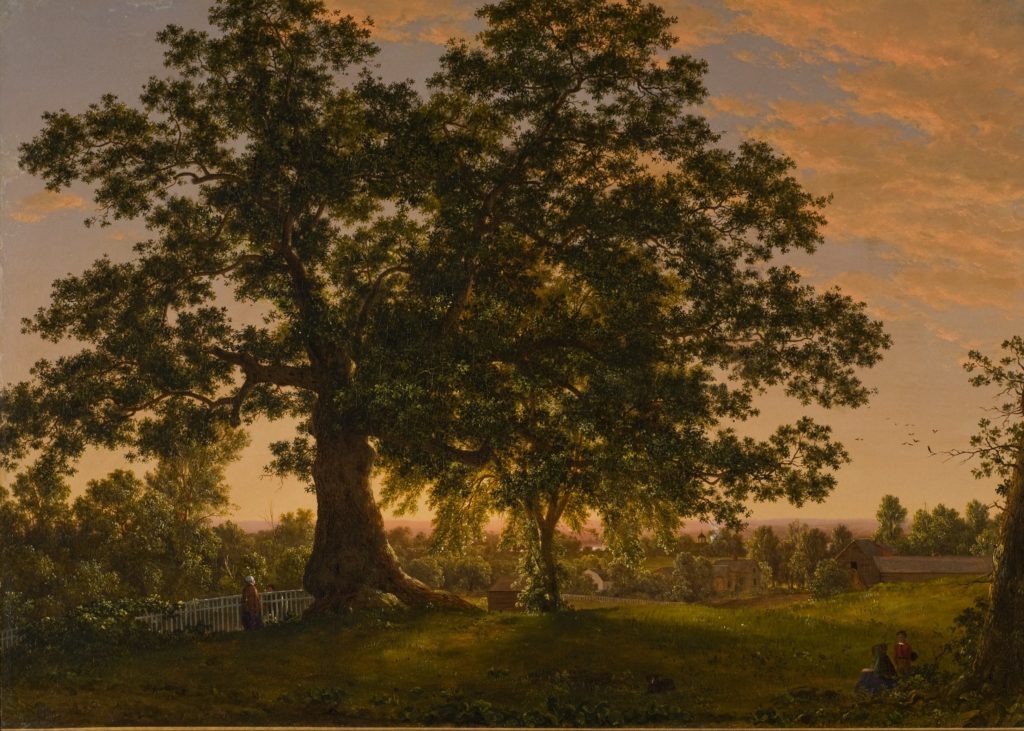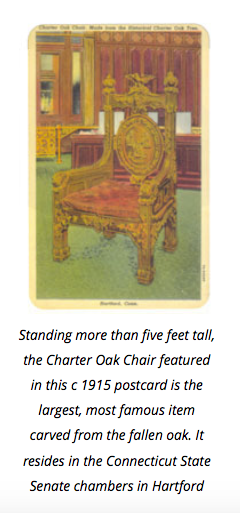The Legend of the Charter Oak

“The Charter Oak” by Frederic Church, 1846. Florence Griswold Museum
The story of the Charter Oak may be Connecticut’s greatest legend. A legend is a story that many believe is historical but there is no proof.
The story takes place in 1687. But first we have to go back to 1662. Connecticut was a colony under British rule. That year, Governor John Winthrop Jr. travelled to England to see King Charles II. Winthrop asked the king for a royal charter for Connecticut. A charter was a written agreement. The Charter of 1662 gave the Connecticut Colony many rights to make decisions without England’s or the king’s approval.
This arrangement lasted for 20 years. In 1685, King Charles died. His brother James II became king. King James had different ideas. He wanted more control over the American colonies. He put the New England colonies into one big colony. He called it the Dominion of New England. Sir Edmund Andros was named governor. Sir Andros demanded that all charters be returned.
Connecticut’s leaders did not want to submit to this new king and his royal governor. Andros came to Hartford to demand that they give up the charter.
On the night of October 27, 1687, Andros met with the colony’s leaders in Hartford. They met at an inn. The charter lay on the table. The meeting went on for hours. Night fell. Still, Connecticut’s leaders refused to give up the charter. All of a sudden, the candles blew out. The room was plunged into darkness. When the candles were lit again, the charter was gone!
The story goes that Joseph Wadsworth took it from the table and ran. He hid it in the hollow of a white oak tree on the property of George Wyllys. This is the part of the story that can’t be proven.
It didn’t really make a difference. Connecticut became part of the Dominion of New England anyway. The colony’s legislature was disbanded. Orders came from Sir Andros.
But King James II only ruled for two years. England had a revolution and William and Mary came to power. For the next 50 or 60 years, England left the colonies alone to govern themselves. Luckily, Connecticut still had its charter. It was recovered from its hiding place. Connecticut began governing itself again as it had before.
The legend first started to be told 100 years later. It was just after the Revolutionary War and the story was wildly popular. It showed our fierce independence. When Connecticut became a state in 1789, it kept using the charter. Connecticut did not adopt a state constitution until 1818.
 The tree where the charter had supposedly been hidden became known as the Charter Oak. When the tree blew over in a storm in 1856, the state mourned its loss. The wood from the tree was made into thousands of keepsakes. A large chair was carved from the wood. It stands in the Connecticut State Senate chambers. Samuel Colt had a cradle carved from the wood for his infant son. Businesses were named for the Charter Oak. Paintings of it were popular. You can see an image of the charter oak on the back of Connecticut’s commemorative quarter.
The tree where the charter had supposedly been hidden became known as the Charter Oak. When the tree blew over in a storm in 1856, the state mourned its loss. The wood from the tree was made into thousands of keepsakes. A large chair was carved from the wood. It stands in the Connecticut State Senate chambers. Samuel Colt had a cradle carved from the wood for his infant son. Businesses were named for the Charter Oak. Paintings of it were popular. You can see an image of the charter oak on the back of Connecticut’s commemorative quarter.
This story was based on “Exploiting the Legend of the Charter Oak” by David Corrigan, Connecticut Explored, Winter 2007-2008.



 The tree where the charter had supposedly been hidden became known as the Charter Oak. When the tree blew over in a storm in 1856, the state mourned its loss. The wood from the tree was made into thousands of keepsakes. A large chair was carved from the wood. It stands in the Connecticut State Senate chambers. Samuel Colt had a cradle carved from the wood for his infant son. Businesses were named for the Charter Oak. Paintings of it were popular. You can see an image of the charter oak on the back of Connecticut’s commemorative quarter.
The tree where the charter had supposedly been hidden became known as the Charter Oak. When the tree blew over in a storm in 1856, the state mourned its loss. The wood from the tree was made into thousands of keepsakes. A large chair was carved from the wood. It stands in the Connecticut State Senate chambers. Samuel Colt had a cradle carved from the wood for his infant son. Businesses were named for the Charter Oak. Paintings of it were popular. You can see an image of the charter oak on the back of Connecticut’s commemorative quarter.